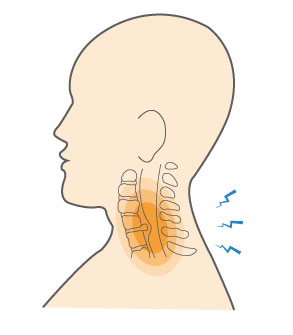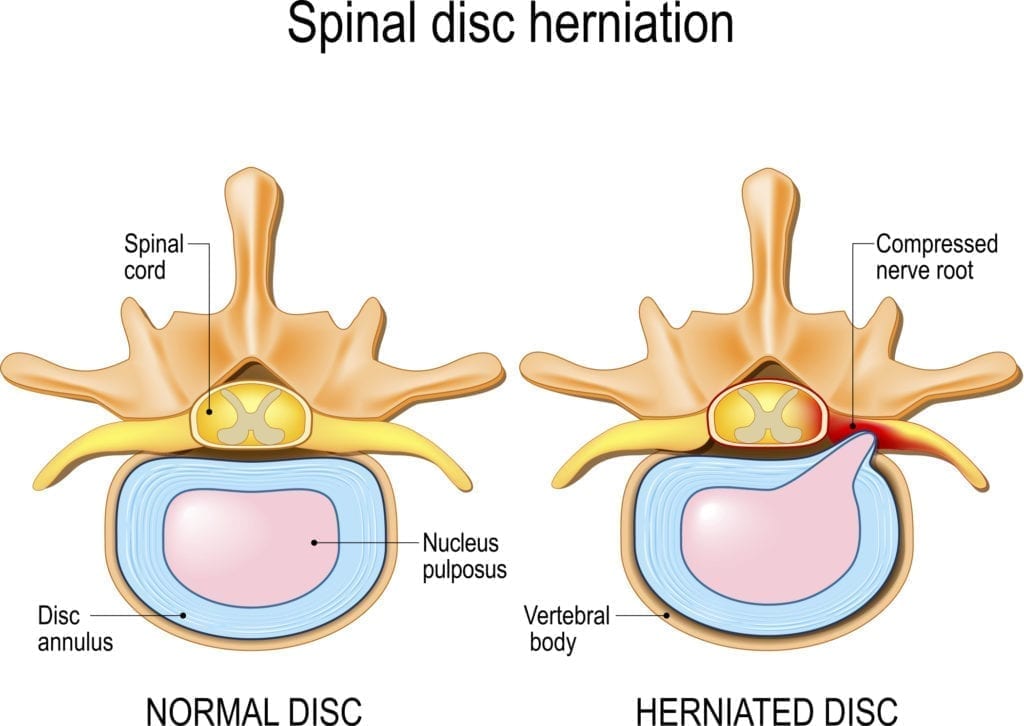Neck and upper back pain is common for many athletes, especially as they age. A herniated cervical disc is often the reason for this pain. Your spine is formed by vertebrae, bones that stack on top of one another to create your spinal column. Between the vertebrae are discs that act as cushions and help give your back flexibility and range of motion. The discs near the neck are called the cervical discs. These discs are hard on the outside but soft and jelly-like in the center. Cervical discs can rupture due to aging and other factors. When this happens, the soft center pushes through the outside. This puts pressure on the nerves in the spinal column, often causing a pinched nerve in the neck, resulting in radiating pain.
Cervical Disc Herniation Causes, Symptoms & Treatment
Neck and upper back pain with radiation is common for many athletes, especially as they age. A herniated cervical disc, sometimes referred to as a disc injury, is often the reason for this pain. When the disc herniates or ruptures, it puts pressure on the nerves in the spinal column, resulting in radiating arm pain.
Overview
Overview

What causes Cervical Disc Herniation?
There are different factors that can cause a cervical disc herniation. With aging, cervical discs can become weakened due to long-term wear and tear. A herniated disc can happen due to overuse, such as lifting something heavy or turning your neck suddenly. Less often, a traumatic injury to the head or neck can also cause this injury.
Cervical disc hernias are most common in these sports:
- Hockey
- Football
- Baseball
- Golf

Symptoms
Symptoms of a herniated disc will depend on the disc’s location along the spine. Cervical disc herniation usually causes pain in the neck and arms. Sometimes, a herniated disc can just cause arm pain, numbness, and weakness without neck pain. These symptoms are referred to as cervical radiculopathy. Common symptoms also include:
- Pain with coughing or sneezing
- Sharp, shooting pain in the arm
- Numbness in the arm
- Muscle weakness in the arm
When to see a doctor
People with neck, shoulder, or arm pain should see their doctor, especially if the pain doesn’t improve within a few days. At your visit, your doctor will conduct a physical examination to see if you have pain when you turn your head or bend your neck and check for other signs of cervical radiculopathy caused by a neck disc bulge or pinched nerve in the neck.
Your doctor may also order x-rays to look at your spine to see if something other than a herniated disc is causing your pain. Other imaging tests, such as a magnetic resonance imaging (MRI) test, can also help confirm a diagnosis.
Non-operative treatment
Treatment of cervical disc herniation is usually successful with non-surgical measures. Conservative treatments include:
- Rest from activities and sports.
- Nonsteroidal anti-inflammatory drugs (NSAIDs), such as ibuprofen and naproxen, to help relieve pain and inflammation
- Muscle relaxers for spasm
- A soft collar around the neck
- Physical therapy
Try these exercises to help address your condition:
Below is a PDF of the Exercise Program
Surgical Treatment
If conservative treatments don’t resolve your symptoms, your doctor may recommend surgery to repair a herniated disc.
Recovery
Recovery from cervical disc herniation can take several weeks. Physical therapy will play an important role in the rehabilitation process.
GET BACK TO WHAT YOU LOVE. FASTER
Frequently Asked Questions
What’s the fastest way to recover from a cervical herniated disc?
Most cases improve with non-surgical treatments such as medication, rest, physical therapy, massage, chiropractic care, and home exercises. Over 95% of people see improvement within six weeks.
How is a cervical disc herniation evaluated?
Assessment involves checking neck mobility and tenderness of the neck muscles. A neurological exam checks muscle strength, sensation, and reflexes.
What happens if a cervical disc herniation is not treated?
Untreated cases can lead to long-term nerve damage and, in severe instances, permanent disability. Even small herniations can cause radiating arm or leg pain.
Is a cervical herniated disc a permanent condition?
Although the disc may not fully heal, symptoms like neck or arm pain typically resolve with proper care in anywhere between a few weeks and 4 to 6 months.

